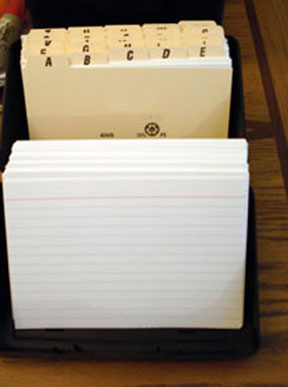In praise of notecards

Beware paper cuts. And fun!
Anyone else use the old-fashioned, classic index cards to compile your scene list?
Sure, your screenwriting software has a super-cool 3D index card “mode” and you can drag-and-drop those shiny digital cards all you want and the edges will never fray and the ink will never smudge because there’s no edges and no ink.
But it’s just not the same. It’s just not as satisfying as that beautiful stack of cards with all your scribbles and cross-outs, is it? You pull off the rubber band with a THWACK and you run your thumb up the left edge of your stack with a DTTTTT and you lay them out on the carpet and you LOOK AT YOUR STORY. It’s all there.
Except for that one scene that obviously doesn’t belong — what were you thinking? So you pick up that card and FLING it into your recycle bin.
BOOM! Editing paradise.
For me, using notecards is like having the script exist, in a complete way, beginning–middle–end, in a physical form, before you start writing it. It’s a way to “feel” the narrative progression — to evaluate it and get inside the story for the first time. And that’s incredibly helpful and also inspiring as you face that daunting blank page.
Writing is tough! Notecards are a tool that can make it a bit easier.
They’re also portable! You can drop your stack of notecards into your pocket and work on them anywhere without worrying about breaking them, if you copied over the latest file or if you installed the right app on your iWhatever.
Use them like flash cards. Keep going over them, over and over, so your narrative is burned in your brain. After all, you have to know your story better than the Reader, better than anyone.
I suggest you write one scene per notecard. Try to limit yourself to a line or two on each card, and underline the major action, the beat that advances the story (hint: if there’s no beat that advances the story, but rather something like “Greg talks to Gina about aardvarks,” then maybe you should think about feeding that recycle bin again?).
It also helps with my Story Maps method. If a scene represents one of your Story Map template beats, then mark the corresponding beat name on the card, always in the same place, say, upper right hand corner (e.g., “Inciting Incident”) for ease of reference. You may find yourself crossing out your Inciting Incident note and assigning it to another scene that’s a stronger candidate for I.I.
Keep an open mind to changes.
Feel free to number the notecards, but be ready to cross out the numbers and re-number. I number them in pencil. It helps to have a count of your total number of scenes and the number in each act, for a rough comparison of how your acts are balanced. I tend to initially cram too many scenes into my first act, but the notecards show me my error — when you have 14 cards in Act One, 8 in Act Two and only 2 in Act Three, you know you have some issues with structure! It’s much easier to see that on paper cards then on your computer monitor as you’re constantly zooming in and out to read the actual text on the digital card.
When first writing your scene list, one scene per card, I suggest you write 25-40 cards to fill a feature-length script. Don’t waste a note card on establishing shots or quick transitions.
I hope you enjoy using index cards. Personally, I not only use them…I also wear them. But that’s a family tradition that’s best left unexplored.
Good luck and Happy Writing,
Dan

I’m looking at my latest story which consists of 40 index cards pinned to a large cork board, divided into four rows with 10 cards each, that I carry around the house—depending on where I choose to write. This method makes it easier to hit the points and turns before the first word is typed. It also exposes “black holes” in the story. I’m looking at a big one right now, but I’d rather work it out with my index cards than in Final Draft.
Sounds great, Gene! I agree that it’s so much easier and more intuitive to look at a board and see your whole story than to scroll down a screen only seeing 1-3 cards at a time. You can zoom out on the computer to see all of your cards, but then you can’t read the writing! Good luck and happy writing in the new year.